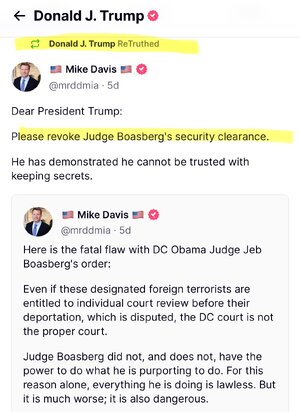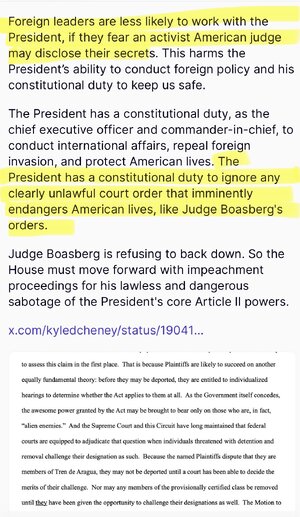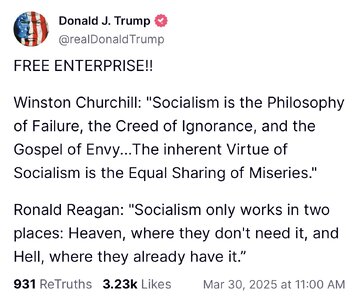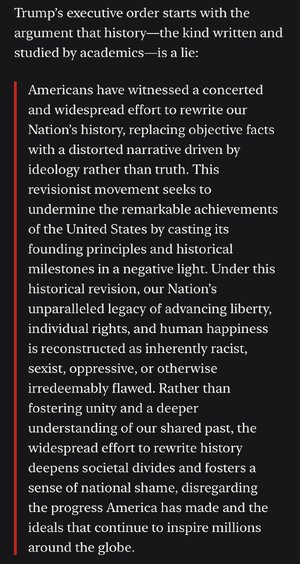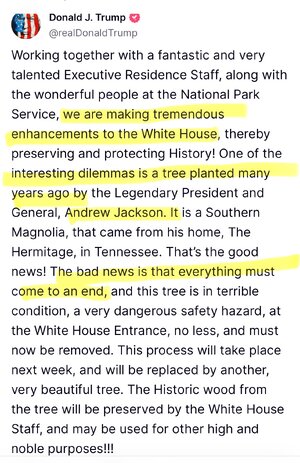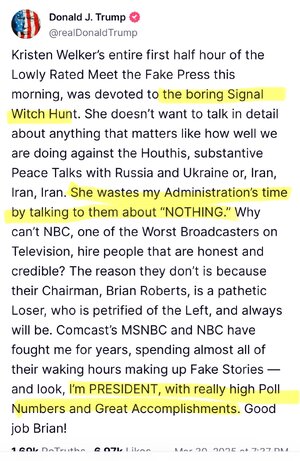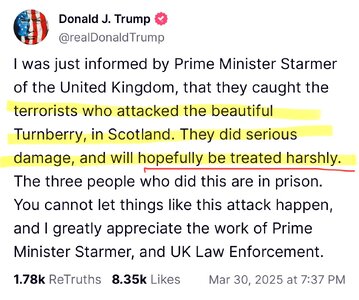Navigation
Install the app
How to install the app on iOS
Follow along with the video below to see how to install our site as a web app on your home screen.
Note: This feature may not be available in some browsers.
More options
You are using an out of date browser. It may not display this or other websites correctly.
You should upgrade or use an alternative browser.
You should upgrade or use an alternative browser.
CURRENT EVENTS MARCH 30 - April 2
- Thread starter nycfan
- Start date
- Replies: 150
- Views: 3K
- Politics
- Status
- Not open for further replies.
- Messages
- 2,203
Might be some women attending under contract.Will there actually be single women attending this conference?
- Messages
- 33,019
Trump seeks takeover of elections in a bid for more presidential power
Rooted in the president’s false claims of election fraud, Trump’s executive order is illustrative of governing through dictates rather than legislation.GIFT LINK
“… The order on elections is more than 2,500 words and at times densely written. It may have received less attention than warranted as it was issued amid the controversy over how sensitive military operational details were shared in a Signal chat group that accidentally included Jeffrey Goldberg, the editor in chief of the Atlantic.
…The Constitution grants most power over elections to the states. When Democrats were pushing a multifaceted voting rights bill known as H.R. 1 during the administration of President Joe Biden, conservative opponents decried the measure as a federal takeover.
So far, there’s been no notable public outcry on the right over the federal takeover that Trump is seeking.
“This is clearly an attempt to federalize election administration to a historic degree, as was H.R. 1,” said Charles Stewart III, a political science professor at the Massachusetts Institute of Technology.
“Certainly liberals and Democrats are going to press the federalism button really hard. And you will get probably some Republican secretaries not pressing it quite as hard, but privately, many of them are going to be pushing back.” …”
- Messages
- 33,019
“…Trump seeks takeover of elections in a bid for more presidential power
Rooted in the president’s false claims of election fraud, Trump’s executive order is illustrative of governing through dictates rather than legislation.
GIFT LINK—> https://wapo.st/4c8CGcZ
“… The order on elections is more than 2,500 words and at times densely written. It may have received less attention than warranted as it was issued amid the controversy over how sensitive military operational details were shared in a Signal chat group that accidentally included Jeffrey Goldberg, the editor in chief of the Atlantic.
…The Constitution grants most power over elections to the states. When Democrats were pushing a multifaceted voting rights bill known as H.R. 1 during the administration of President Joe Biden, conservative opponents decried the measure as a federal takeover.
So far, there’s been no notable public outcry on the right over the federal takeover that Trump is seeking.
“This is clearly an attempt to federalize election administration to a historic degree, as was H.R. 1,” said Charles Stewart III, a political science professor at the Massachusetts Institute of Technology.
“Certainly liberals and Democrats are going to press the federalism button really hard. And you will get probably some Republican secretaries not pressing it quite as hard, but privately, many of them are going to be pushing back.” …”
The executive order says that federal law establishes a “uniform Election Day” and adds: “It is the policy of my Administration to enforce those statutes and require that votes be cast and received by the election date established in law.”
The order cites the findings of an election law case, Republican National Committee v. Wetzel, decided last year by the U.S. Court of Appeals for the 5th Circuit. In that case, a three-judge panel struck down a Mississippi law that allowed for ballots postmarked by Election Day to be counted after the election. The ruling overturned a lower court decision upholding the Mississippi law….”
- Messages
- 33,019
“…
The executive order says that federal law establishes a “uniform Election Day” and adds: “It is the policy of my Administration to enforce those statutes and require that votes be cast and received by the election date established in law.”
The order cites the findings of an election law case, Republican National Committee v. Wetzel, decided last year by the U.S. Court of Appeals for the 5th Circuit. In that case, a three-judge panel struck down a Mississippi law that allowed for ballots postmarked by Election Day to be counted after the election. The ruling overturned a lower court decision upholding the Mississippi law….”
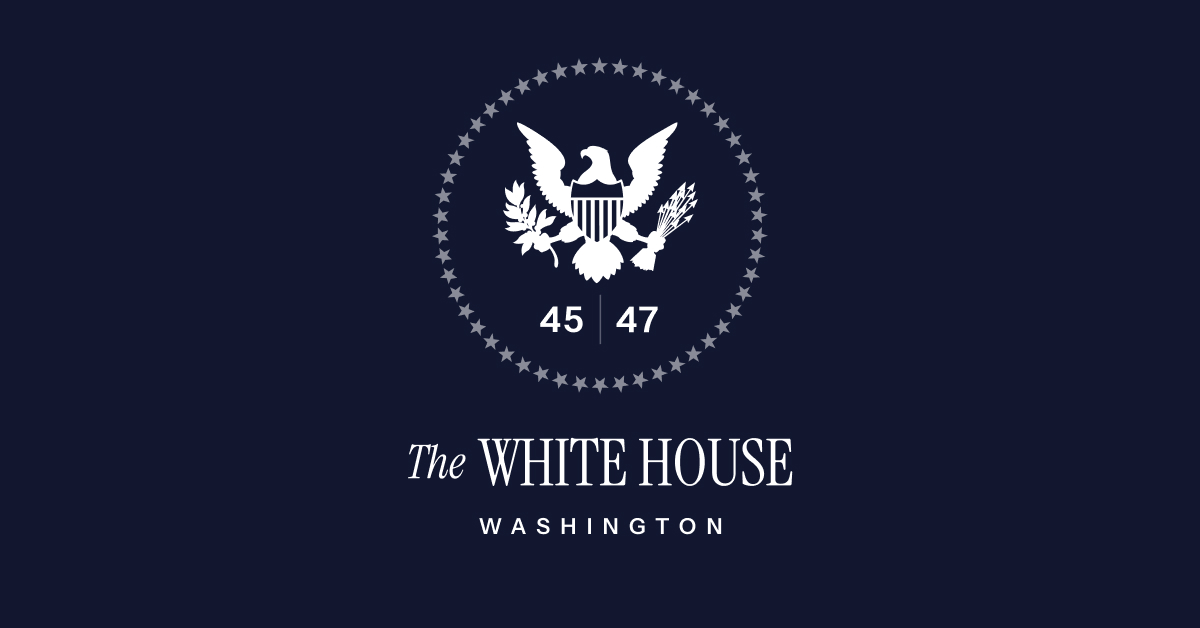
Preserving and Protecting the Integrity of American Elections
By the authority vested in me as President by the Constitution and the laws of the United States of America, it is hereby ordered: Section 1. Purpose and
www.whitehouse.gov
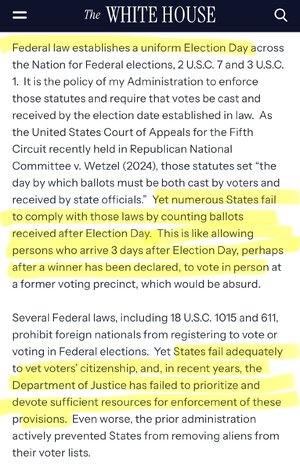
- Messages
- 33,019
Trump threatens to bomb Iran
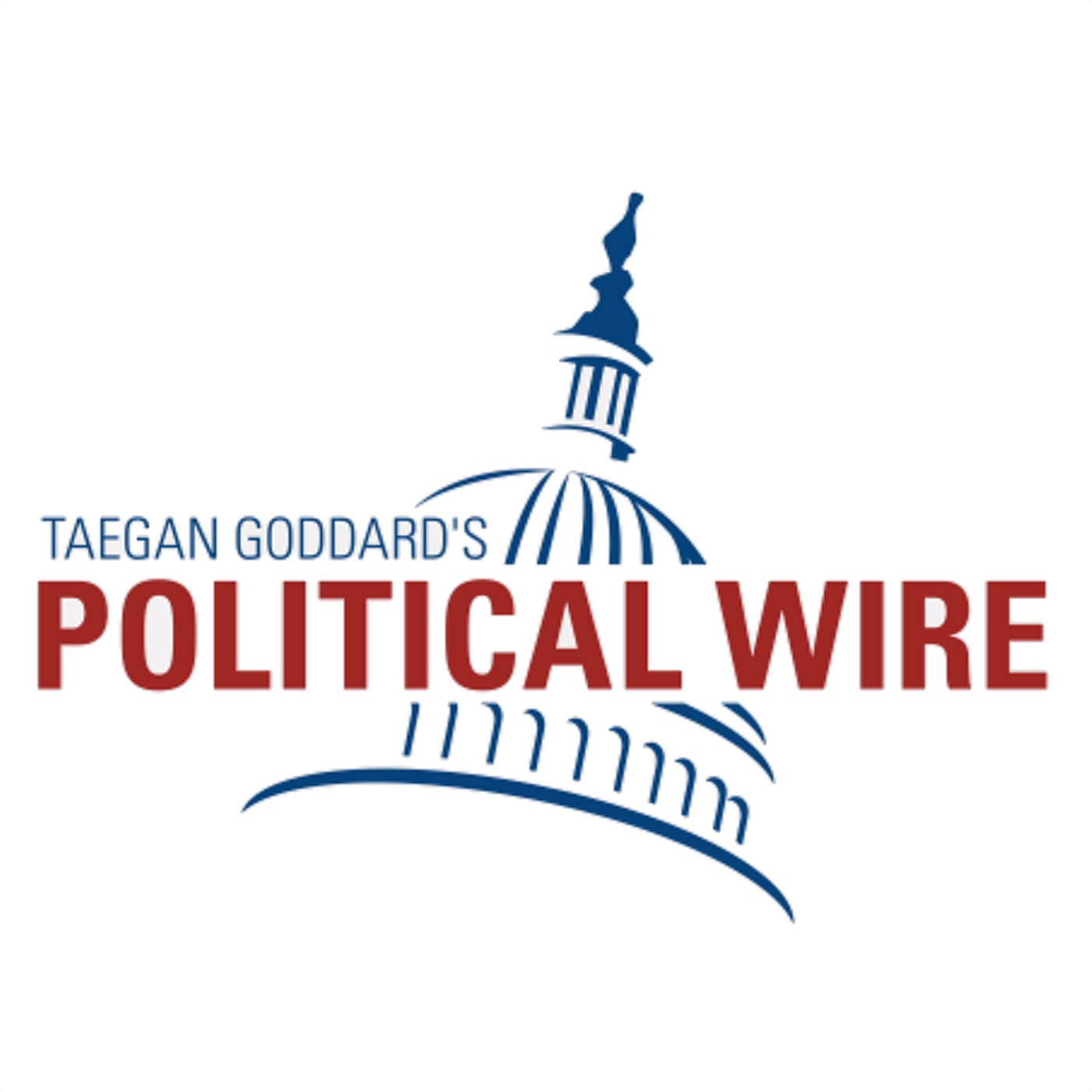
 politicalwire.com
politicalwire.com

Trump Threatens to Bomb Iran
President Trump threatened Iran with bombings and secondary tariffs if Tehran did not come to an agreement with Washington over its nuclear program, Reuters reports. Said Trump: "If they don't make a deal, there will
- Messages
- 33,019
Trump used Iran as a distraction during his first impeachment during his first term (late 2019), so that could be the goal here … but he is also so all over the map on tariffs and other policies, it seems unwise to assume this is only an attempt to drown out Signalgate and bad tariff coverage …Trump threatens to bomb Iran

Trump Threatens to Bomb Iran
President Trump threatened Iran with bombings and secondary tariffs if Tehran did not come to an agreement with Washington over its nuclear program, Reuters reports. Said Trump: "If they don't make a deal, there willpoliticalwire.com
FLASHBACK 2019:
An Abrupt Move That Stunned Aides: Inside Trump’s Aborted Attack on Iran

An Abrupt Move That Stunned Aides: Inside Trump’s Aborted Attack on Iran (Published 2019)
President Trump’s decision to call off an airstrike on Iran in June looms large now as he weighs how to respond to attacks on oil facilities in Saudi Arabia blamed on Tehran.
“…
By the time President Trump met with congressional leaders on the afternoon of June 20, he had already decided to retaliate against Iran for shooting down an American surveillance drone. But for once, he kept his cards close to the vest, soliciting advice rather than doing all of the talking.
“Why don’t you go after the launch sites?” a Republican lawmaker asked.
“Well,” Mr. Trump replied with a hint, “I think you’ll like the decision.”
But barely three hours later, Mr. Trump had changed his mind. Without consulting his vice president, secretary of state or national security adviser, he reversed himself and, with ships readying missiles and airplanes already in the skies, told the Pentagon to call off the airstrikeswith only 10 minutes to go. When Vice President Mike Pence and other officials returned to the White House for what they expected would be a long night of monitoring a military operation, they were stunned to learn the attack was off. …”
FLASHBACK LATE 2019 -2020:

The Trump Administration’s Escalating Tension with Iran - American Oversight
American Oversight launched an investigation to shed light on the Trump administration’s management of foreign policy decisions regarding Iran.
“On Jan. 2, 2020, the Pentagon announcedthat it had carried out a military strike in Iraq that killed the commander of the Iranian Quds Force, Maj. Gen. Qasem Soleimani. The targeting of one of Iran’s most senior officials was seen as a major escalation in the increasingly hostile relationship between the U.S. and Iran, and then-President Donald Trump’s bellicose threats on Twitter — including threats to target sites “important to Iran & the Iranian culture” — suggested that de-escalation was not a White House priority. …”
“… Back in the spring of 2019, alarm grew about whether the administration was laying the legal groundwork for military action against Iran when the State Department announced that it would designate Iran’s Islamic Revolutionary Guard Corps as a foreign terrorist organization, saying that “Iran continues to allow al Qaeda operatives to reside in Iran.” The 2001 Authorization for the Use of Military Force (AUMF) gave the executive branch broad authority to use military force against states or entities should it determine that they harbored those who aided or planned the September 11 attacks, and another AUMF was adopted in 2002 to authorize the Iraq war. In May 2019, the administration revised its military plans for potential conflict with Iran, elevating concerns even further and prompting American Oversight to file a number of Freedom of Information Act requests for related legal analyses.
… The coronavirus pandemic and the Trump administration’s bungled response to it has turned significant attention away from the alarming increase in hostility between the U.S. and Iran, but questions remain about whether the administration had been making preparations for further escalation — and whether its sidelining of Congress reflects a contempt for Congress’s constitutionally delegated war powers. …”
Last edited:
- Messages
- 33,019
Trump threatens to bomb Iran

Trump Threatens to Bomb Iran
President Trump threatened Iran with bombings and secondary tariffs if Tehran did not come to an agreement with Washington over its nuclear program, Reuters reports. Said Trump: "If they don't make a deal, there willpoliticalwire.com
Mulberry Heel
Inconceivable Member
- Messages
- 3,411
“… It’s not just about the Smithsonian Institution, or its American Art Museum, or the 250th anniversary of the Declaration of Independence. The executive order Trump signed on March 27, “Restoring Truth and Sanity to American History,” is part of a much larger project of reframing America. If you’ll forgive me for quoting George Orwell’s Nineteen Eighty-Four (banned from schools in my state of Iowa until a judge temporarily intervened), “Who controls the past controls the future. Who controls the present controls the past.”
In one sense, this pithy saying is not true: Professional historians, even if you think they control the past, have very little power over the present or the future, as the continuing demolition of the academic humanities makes plain. But the maxim is one of the bedrocks of how tyranny engages with history: crafting a mythic golden age that “they” “stole” from “us.” Totalitarians know how to tell a good story with friends and enemies, heroes and villains. …
… Trump claims to respect historical truth, which he contrasts with falsehoods engendered by ideology.
Yet his obvious project is really not to eliminate ideology from history but to rewrite American history—to collapse the complicated, messy story of people and places into a simplified, mythical past that suits his tawdry present.
In Trump’s false American past, our country has never done anything it should be ashamed of: not slavery; not genocidal wars of conquest and occupation against Native Americans; not Jim Crow; not multiple iterations of the Ku Klux Klan that could muster 60,000-man open, unmasked marches in D.C. in the 1920s; not “Indian boarding schools” and their unmarked mass graves; not the massive growth of eugenics as a science in the United States;1 not the White Power movement of the 1970s and 1980s. …”
Anyone who cares about American education and accurately teaching history ought to find this move by Trump to be chilling. Although its implications will not be immediately felt, if this is successful there will be enormous pressure on public schools and colleges and universities to change their history curriculum to conform with these new dictates. And the College Board's AP history classes will almost certainly be a major target as well, and they've already indicated a willingness to bend and conform in the AP African American course brouhaha in Florida with Ron DeSantis. And it's worth noting that this is exactly what Viktor Orban did in Hungary to his nation's schools and universities - create a "patriotic" history agenda and curriculum that was forced onto schools and teachers. Again, it will likely take some time - perhaps even a few years - to worm its way through the educational system, but if successful it would basically return schools to a kind of 1950s "teach only about white folks and rah-rah patriotism" kind of history. Yet another major attempt by this administration to force all of us, willing or not, back to some imaginary earlier "golden age" before all of the social and cultural changes of the last fifty or sixty years.
Last edited:
superrific
Master of the ZZLverse
- Messages
- 10,899
1. FYI, the 5th circuit case about absentee ballots needing to be received before election day -- the one cited above -- is, shall we say, a bit lacking. In that case, the state said that a vote was cast when put in the mail. And here is the entirety of the court's argument on that point:
First, official action. Foster teaches that elections involve an element of government action.“When the federal statutes speak of ‘the election’ of a Senator or Representative, they plainly refer to the combined actions of voters and officials meant to make a final selection of an officeholder.” The State contends that “an election official’s only necessary involvement is giving a voter the means to make a final selection—such as by offering a ballot and a method to cast it.”
The State’s problem is that it thinks a ballot can be “cast” before it is received. What if a State changes its law to allow voters to mark their ballots and place them in a drawer? Or what if a State allowed a voter to mark a ballot and then post a picture on social media? The hypotheticals are obviously absurd. But it should be equally obvious that a ballot is “cast” when the State takes custody of it.
That's it. In its entirety. I don't know if I have ever seen quite anything like this from a federal appeals court. Even other Fifth Circuit judges are like, "put some effort into it."
Literally, the argument here is: a) here are some ridiculous hypotheticals of barely perceptible relevance; b) they are absurd; c) duh, don't you know when a ballot is cast?
2. It gets worse. Seriously. Here's another gem from just a bit later.
The considerable historical support for absentee voting says nothing about whether States can extend the election past the uniform, singular Election Day required by federal law. Instead, the practice of absentee voting that arose during the Civil War demonstrates that the election concludes when all ballots are received. A few “late-in-time outliers” say nothing about the original public meaning of the Election-Day statutes.
Note that the "considerable historical support" was described by the court in the six PAGES preceding this paragraph. So here the argument is:
a) there's considerable historical support for absentee voting including counting of ballots received after election day; b) but because election officials carried ballot boxes to soldiers in a civil war (when mail service was, shall we say, unreliable); c) we're going to ignore all the evidence we just described because it doesn't go where we want it to go.
3. I don't how to emphasize how shocking this is. Maybe not surprising, but it should be shocking. This opinion wouldn't make it past the first round of any appellate writing contest in law school. When students would write papers with this sort of conclusory bullshit, I would send them back and make them fix it -- a practice that was enthusiastically endorsed by my colleagues (even if they didn't do it because it was more work for them).
First, official action. Foster teaches that elections involve an element of government action.“When the federal statutes speak of ‘the election’ of a Senator or Representative, they plainly refer to the combined actions of voters and officials meant to make a final selection of an officeholder.” The State contends that “an election official’s only necessary involvement is giving a voter the means to make a final selection—such as by offering a ballot and a method to cast it.”
The State’s problem is that it thinks a ballot can be “cast” before it is received. What if a State changes its law to allow voters to mark their ballots and place them in a drawer? Or what if a State allowed a voter to mark a ballot and then post a picture on social media? The hypotheticals are obviously absurd. But it should be equally obvious that a ballot is “cast” when the State takes custody of it.
That's it. In its entirety. I don't know if I have ever seen quite anything like this from a federal appeals court. Even other Fifth Circuit judges are like, "put some effort into it."
Literally, the argument here is: a) here are some ridiculous hypotheticals of barely perceptible relevance; b) they are absurd; c) duh, don't you know when a ballot is cast?
2. It gets worse. Seriously. Here's another gem from just a bit later.
The considerable historical support for absentee voting says nothing about whether States can extend the election past the uniform, singular Election Day required by federal law. Instead, the practice of absentee voting that arose during the Civil War demonstrates that the election concludes when all ballots are received. A few “late-in-time outliers” say nothing about the original public meaning of the Election-Day statutes.
Note that the "considerable historical support" was described by the court in the six PAGES preceding this paragraph. So here the argument is:
a) there's considerable historical support for absentee voting including counting of ballots received after election day; b) but because election officials carried ballot boxes to soldiers in a civil war (when mail service was, shall we say, unreliable); c) we're going to ignore all the evidence we just described because it doesn't go where we want it to go.
3. I don't how to emphasize how shocking this is. Maybe not surprising, but it should be shocking. This opinion wouldn't make it past the first round of any appellate writing contest in law school. When students would write papers with this sort of conclusory bullshit, I would send them back and make them fix it -- a practice that was enthusiastically endorsed by my colleagues (even if they didn't do it because it was more work for them).
- Status
- Not open for further replies.
Share:

